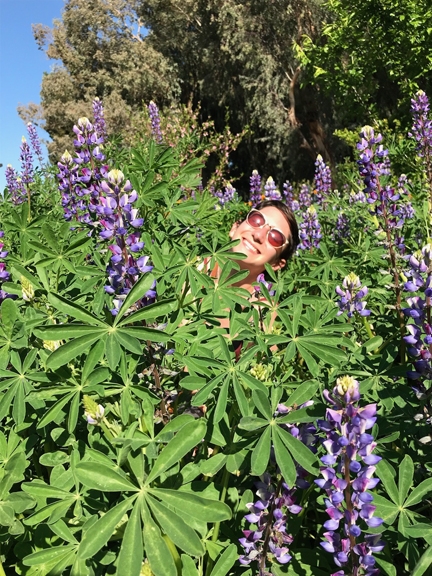
Not so with the Biological Orchard and Gardens (BOG) on the University of California, Davis, campus. It's a 24,000-square foot treasure, a living museum planted not only with several dozen species of heritage fruit trees, but landscaped with colorful mini-gardens.
This spring scores of wildflowers bloomed in awe-stopping glory, prompting passersby to pull out their cell phones and take selfies.
“The project began in 2010 when a group of students raised the money to convert an under-utilized lawn into a working orchard with fruits free for everyone to enjoy,” related former student project manager and now BOG volunteer Emily Dorrance. She recently graduated with a bachelor of science degree in environmental policy analysis and planning.
“Since then, the team has grown to involve many other UC Davis faculty, staff, and student groups," Dorrance said. ”Ernesto Sandoval, manager and curator of the UC Davis Botanical Conservatory, has been an advisor to the BOG student leadership for many years now and continues to be an important partner!”
At its core, BOG is a collaboration of students, staff and academic programs and an outdoor ecological laboratory that directly supports the university's popular Introduction to Biology course. Or, as the BOG Facebook page indicates: "An agro-biodiverse collaboration between students, staff, academic specialists and programs at UC Davis!"
BOG is located in front (or back) of the Mann Laboratory on Kleiber Hall Drive, depending on which way you're going! If you park in Lot 26, off Kleiber Hall Drive, it's a short walk down the sidewalk to BOG.
"The orchard you see today was planted two years ago," Dorrance noted. "The wildflowers were seeded four years ago and continue to self-seed, with some supplementation.We're planning on planting some more permanent plantings in the fall. The Mediterranean plots surrounding the orchard will have some more seasonal variety as well! I don't think we have any major planting plans for this summer but that could change!"
Among the flowers blooming in the Bog in the early spring, by color:
- Red: European red flax, Linum grandiflorum rubrum, an annual that's native to Algeria
- Yellow: tidy tips, Layia platyglossa, an annual that's native to California
--The seep monkey flower, Mimulus guttatus, native to California
--Lupine, Lupinus, native to North America. - Blue: Desert bell, Phacelia campanularia, an annual herb that is native to California and endemic (limited) to California.
- Lavender: Phacelia, also called Lacy phacelia, blue tansy or purple tansy (Phacelia tanacetifolia), native to the southwestern United States
--Lupine: Lupinus, native to North America - Red-Orange-Yellow: Blanket flower or Gaillardia (Gaillardia × grandiflora), native to North and South America
- Orange: California golden poppies, Eschscholtzia californica
The orchard contains heritage fruit tree varieties threatened with commercial extinction. They include the Gravenstein and Johnathan apples; the Suncrest peach; the Bleinheim apricot, the Mariposa plum and the Meyer lemon. See the full list of trees as well as some fun facts here: https://thebogatucd.wixsite.com/bogucd/single-post/2017/07/18/BOG-Fruit-Trees.
In 2013 BOG received a "Go Green" grant from the UC Davis Dining Services. Then last month, the Green Initiative Fund (TGIF) awarded $19,934 to the BOG for final site development. It was a major effort. (On its Facebook page, BOG thanks Kelly Richmond and Andra George for help on the grant and supporters Geoffrey Benn, Ivana Li, Pat Randolph, Lee Anne Richmond, and Peter Hartsough.)
Future plans? According to the website: "The BOG is joining the campuswide effort in transitioning towards a landscaping genre that embraces lawn reduction and plantings more suitable for the teaching, outreach and research mission of the university and sustainability practices. The motivation for the BOG is to serve as a teaching garden for multiple university courses and provide a relaxing space to enjoy the outdoors and simply delicious fruit. The BOG's main function is to serve a demonstration of and test site for plants more suitable to the region's hot dry summers and cool wet winters, with a focus on drought tolerant plants less commonly available in the Sacramento Valley."
When we stopped by the BOG in mid-April, the Phacelia tanacetifolia proved to be a favorite: honey bees (Apis mellifera), male and female Valley carpenter bees (Xylocopa varipuncta) and yellow-faced bumble bee (Bombus vosnesenskii) were all over it. It's fairly uncommon to see male Valley carpenter bees--"teddy bear bees" or green-eyed blonds--foraging, but there they were, along with the female of the species. "The girls" are solid black in a clear-cut case of sexual diphormism.
Want to get involved? The BOG seeks volunteers, interns and donors. See its website at https://thebogatucd.wixsite.com/bogucd or its Facebook page at www.facebook.com/ucdBOG or email "thebogatucd@gmail.com."
You can even adopt a tree!
Or become buddies with a bee!
(Note: Most of the annual wildflowers have "passed" since our visit in mid-April, but the orchard is thriving with newly formed fruit.)
Attached Images:
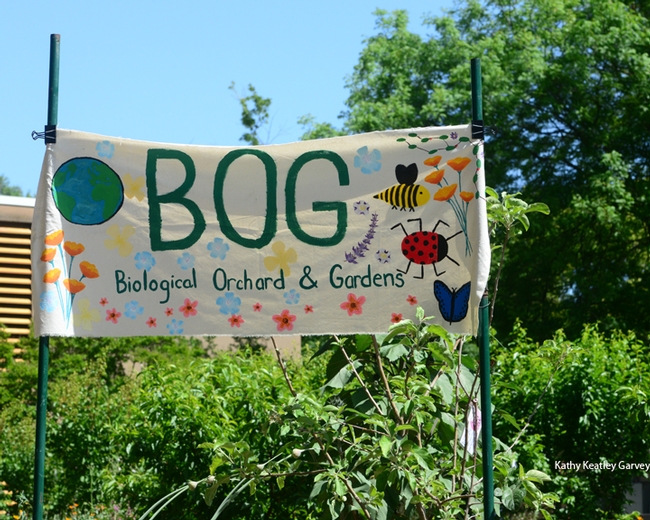
The Biological Orchard and Gardens (BOG) sign features floral and insect designs. It's located by the Mann Laboratory, UC Davis campus. (Photo by Kathy Keatley Garvey)
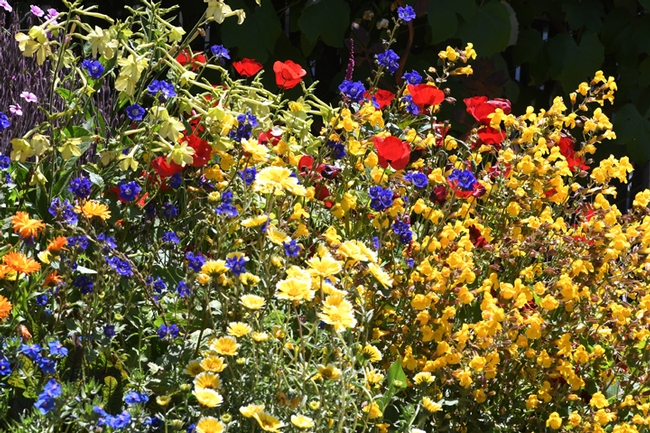
Colorful BOG garden in the early spring: among the flowers are tidy tips, desert bell, and European red flax. (Photo by Kathy Keatley Garvey)
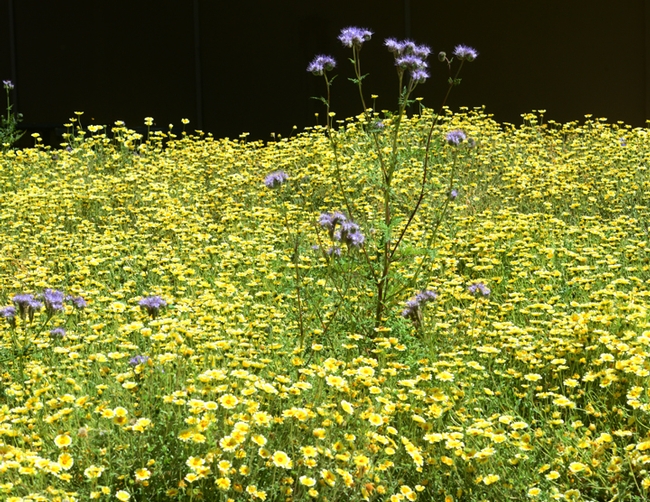
A mini-meadow of tidy tips, Layia platyglossa, with tall phacelia, Phacelia tanacetifolia. (Photo by Kathy Keatley Garvey)
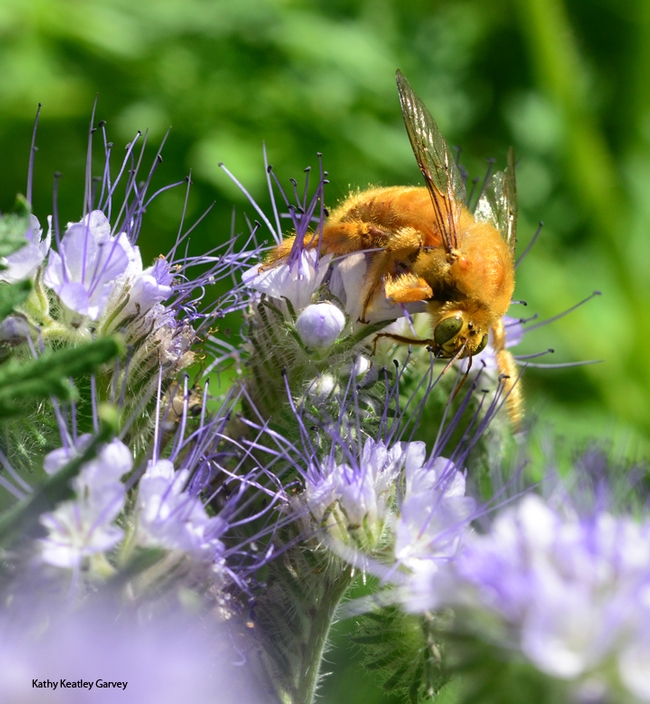
A male Valley carpenter bee, (Xylocopa varipuncta) forages on phacelia. (Photo by Kathy Keatley Garvey)
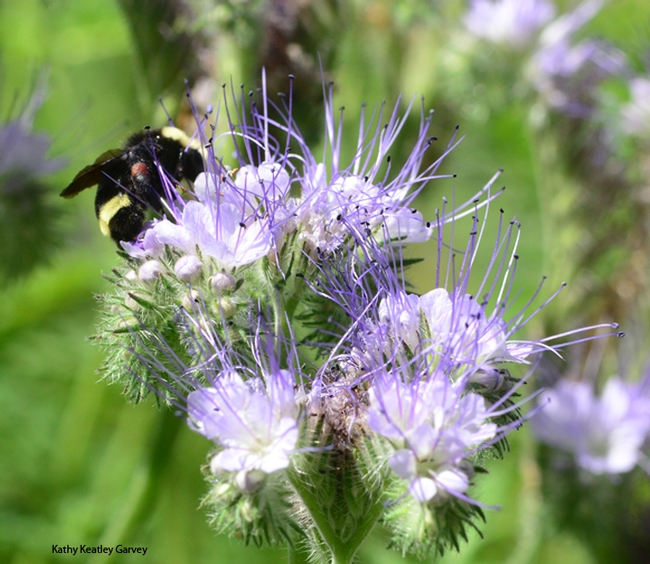
A yellow-faced bumble bee (Bombus vosnesenskii) sips nectar from phacelia. (Photo by Kathy Keatley Garvey)
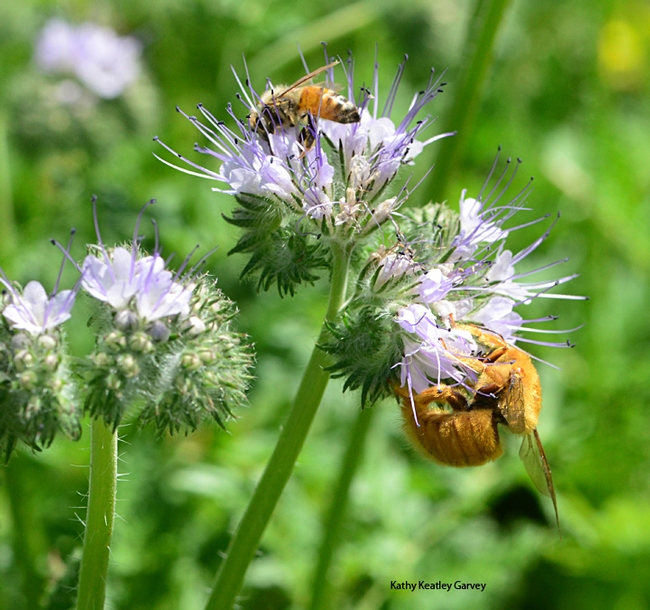
Size comparison! A honey bee is dwarfed by a male Valley carpenter bee, Xylocopa varipuncta. (Photo by Kathy Keatley Garvey)
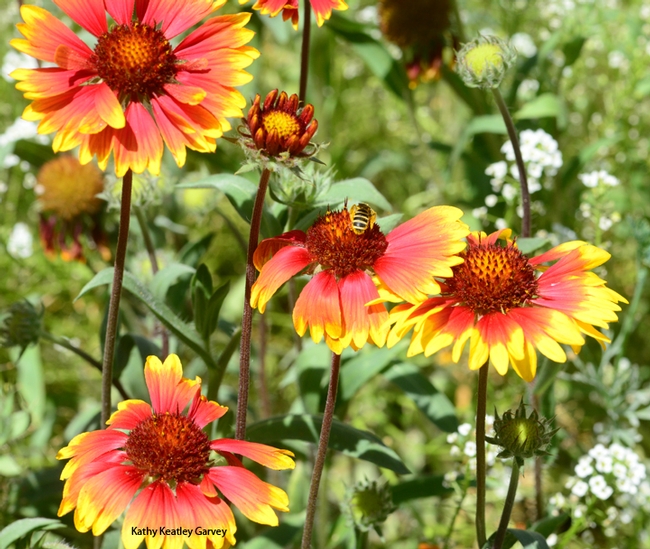
Many species of bees--as well as butterflies and other insects--are drawn to the blanketflower, Gaillardia. (Photo by Kathy Keatley Garvey)